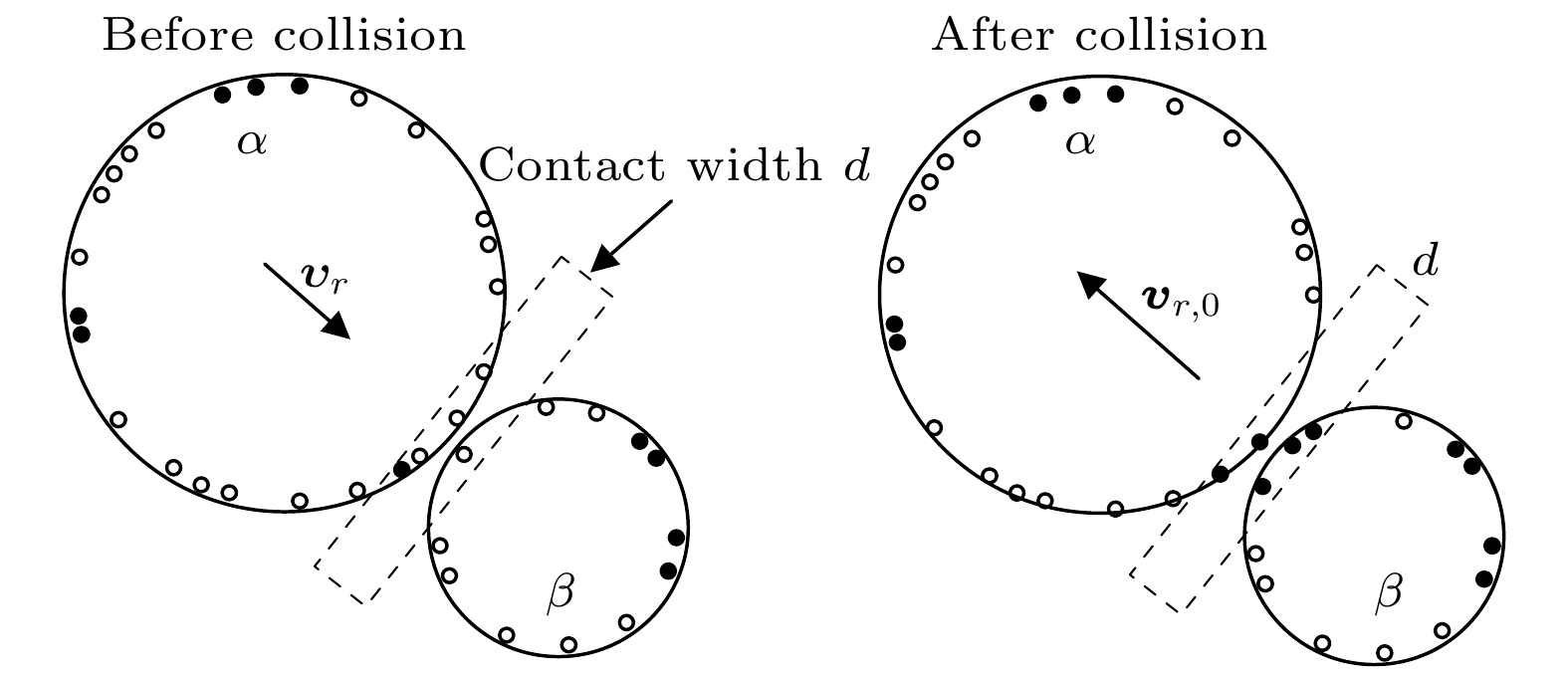-
Triboelectrification in an insulative granular system is a common natural phenomenon, but until now it has not been well understood. The space on the moon or Mars is suffused by a large amount of fine dust. These tiny dust particles are so adhesive that they can easily stick to any exposed surfaces, which may provoke serious problems, such as reducing the efficiency of solar panels, and resulting in the thermal control failure and the false instrument readings. In recent years, dust removal by using an electrodynamic field is considered as an effective method to mitigate dust pollution. Research shows that the triboelectrification on the particle surface contributes most to the electrostatic source of lunar dust. Consequently, the study of the mechanism of triboelectrification is very important in removing dust particles. In this paper, an analytical model based on the high-energy electron hypothesis is developed to predict the triboelectric charge distribution among particles. The particle size dependence of the tribo-charge is obtained, and the influence of the size range on the tribo-charge probability is also demonstrated. An upper limit for the charge distribution is revealed, and its possible cause is discussed. The particle dynamics simulation is carried out to investigate the charge transfer during particle collisions, thereby verifying the prediction results obtained by theoretical analysis.
-
Keywords:
- triboelectrification /
- insulative granular system /
- high-energy state electron /
- particle dynamics simulation
[1] Gilbert J S, Lane S J, Koyaguchi T, Sparks R S J 1991 Nature 349 598
 Google Scholar
Google Scholar
[2] Stow C D 1969 Weather 24 134
 Google Scholar
Google Scholar
[3] Mills A A 1977 Nature 268 614
[4] Eden H F, Vonnegut B 1973 Science 180 962
 Google Scholar
Google Scholar
[5] Calle C I, Mazumder M K, Immer C R, Buhler C R, Clements J S, Lundeen P, Chen A, Mantovani J G 2008 J. Phys. 142 012073
[6] Kawamoto H, Hasegawa N 2004 J. Imaging Sci. Techn. 48 404
[7] Watanabe H, Ghadiri M, Matsuyama T, Ding Y L, Pitt K G, Maruyama H, Matsusaka S, Masuda H 2007 Int. J. Pharm. 334 149
 Google Scholar
Google Scholar
[8] Sickafoose A A, Colwell J E, HorãiNyi M, Robertson S 2001 J. Geophy. Research: Space Phys. 106 8343
 Google Scholar
Google Scholar
[9] Lacks D J, Levandovsky A 2007 J. Electrost. 65 107
 Google Scholar
Google Scholar
[10] Lacks D J, Duff N, Kumar S K 2008 Phys. Rev. Lett. 100 188305
 Google Scholar
Google Scholar
[11] Forward K M, Lacks D J, Sankaran R M 2009 J. Geophys. Res-Space 114 A10109
 Google Scholar
Google Scholar
[12] Hu W W, Li X, Zheng X J 2012 Eur. Phys. J. E 35 1
 Google Scholar
Google Scholar
[13] Kok J F, Lacks D J 2009 Phys. Rev. E 79 051304
 Google Scholar
Google Scholar
[14] Lowell J, Truscott W S 1986 J. Phys. D-Appl. Phys. 19 1281
 Google Scholar
Google Scholar
[15] Duff N, Lacks D J 2008 J. Electrost. 66 51
 Google Scholar
Google Scholar
[16] Zon R V, Cohen E G D 2006 J. Stat. Phys. 123 1
 Google Scholar
Google Scholar
[17] Forward K M 2009 Ph. D. Dissertation (Ohio: Case Western Reserve University)
-
图 1 二维情形下碰撞前后颗粒高能态电子在接触面处发生转移转化为稳定低能态电子的过程(图中黑点为高能态电子, 黑圈为低能态电子)
Figure 1. In the two-dimensional case the high-energy electrons of particles transfer to stable low-energy electrons at the interface before and after collision (the black dots are high energy electrons, the black circles are low energy electrons).
-
[1] Gilbert J S, Lane S J, Koyaguchi T, Sparks R S J 1991 Nature 349 598
 Google Scholar
Google Scholar
[2] Stow C D 1969 Weather 24 134
 Google Scholar
Google Scholar
[3] Mills A A 1977 Nature 268 614
[4] Eden H F, Vonnegut B 1973 Science 180 962
 Google Scholar
Google Scholar
[5] Calle C I, Mazumder M K, Immer C R, Buhler C R, Clements J S, Lundeen P, Chen A, Mantovani J G 2008 J. Phys. 142 012073
[6] Kawamoto H, Hasegawa N 2004 J. Imaging Sci. Techn. 48 404
[7] Watanabe H, Ghadiri M, Matsuyama T, Ding Y L, Pitt K G, Maruyama H, Matsusaka S, Masuda H 2007 Int. J. Pharm. 334 149
 Google Scholar
Google Scholar
[8] Sickafoose A A, Colwell J E, HorãiNyi M, Robertson S 2001 J. Geophy. Research: Space Phys. 106 8343
 Google Scholar
Google Scholar
[9] Lacks D J, Levandovsky A 2007 J. Electrost. 65 107
 Google Scholar
Google Scholar
[10] Lacks D J, Duff N, Kumar S K 2008 Phys. Rev. Lett. 100 188305
 Google Scholar
Google Scholar
[11] Forward K M, Lacks D J, Sankaran R M 2009 J. Geophys. Res-Space 114 A10109
 Google Scholar
Google Scholar
[12] Hu W W, Li X, Zheng X J 2012 Eur. Phys. J. E 35 1
 Google Scholar
Google Scholar
[13] Kok J F, Lacks D J 2009 Phys. Rev. E 79 051304
 Google Scholar
Google Scholar
[14] Lowell J, Truscott W S 1986 J. Phys. D-Appl. Phys. 19 1281
 Google Scholar
Google Scholar
[15] Duff N, Lacks D J 2008 J. Electrost. 66 51
 Google Scholar
Google Scholar
[16] Zon R V, Cohen E G D 2006 J. Stat. Phys. 123 1
 Google Scholar
Google Scholar
[17] Forward K M 2009 Ph. D. Dissertation (Ohio: Case Western Reserve University)
Catalog
Metrics
- Abstract views: 7107
- PDF Downloads: 128
- Cited By: 0















 DownLoad:
DownLoad:



